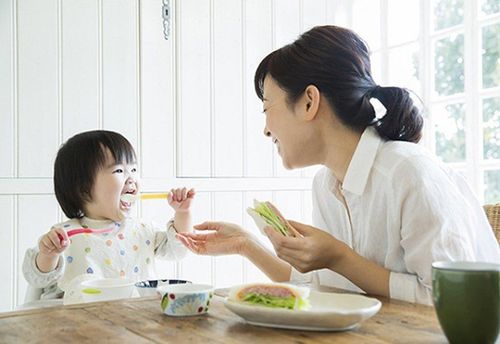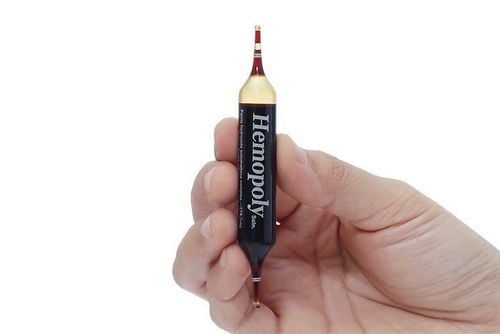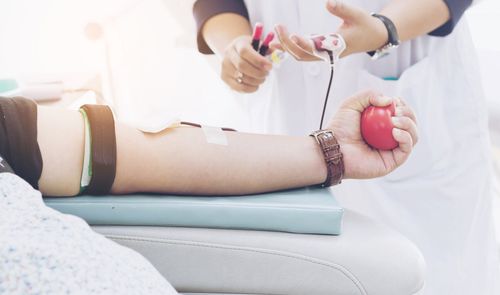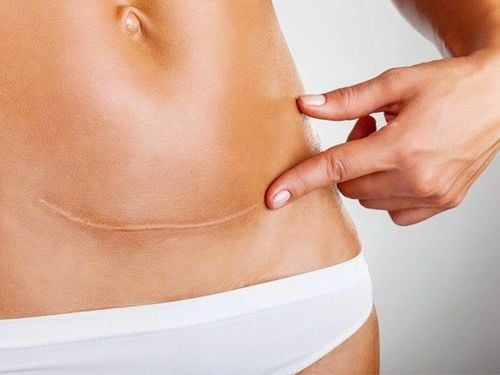This is an automatically translated article.
The article is professionally consulted by Master, Doctor Huynh Bao Toan - Department of Pediatrics - Neonatology - Vinmec Nha Trang International General Hospital.Young children need a lot of important nutrients, including iron. This is an element that contributes to blood formation, immune system and hormone balance for children. This article helps you understand more about iron supplementation from food for young children.
1. The importance of iron for young children
Iron is an essential nutrient that the body uses to produce hemoglobin. This is a protein in red blood cells that helps your blood carry oxygen to all other cells in your body. Iron is necessary for the supply of oxygen to the body, the metabolism of proteins, the creation of muscle cells, the maintenance of connective tissue, the physiological development of the body, nerve development, cell function and production. secrete certain hormones.Breastfed babies usually get enough iron from breast milk, while formula-fed babies must receive iron-fortified formula.
2. Consequences of Iron Deficiency
One of the most common risks of iron deficiency is iron deficiency anemia. When babies start transitioning to regular foods, they may not be getting enough iron. However, this condition is not common, only 8 percent of toddlers are iron-deficient. Even so, low iron levels can lead to anemia, in which the red blood cell count in a child's body is too low, potentially causing a lack of oxygen to vital organs.If your child has low iron, you may notice that they may have symptoms such as pale skin, being irritable, and not wanting to eat. In the long term, this condition can lead to more dangerous conditions such as slower growth, delayed motor skill development, and higher susceptibility to infections, as iron supports the immune system.
Symptoms may not appear at first, but over time your child may experience such as fatigue, pale skin, irritability, fast or irregular heartbeat, decreased appetite, slow weight gain, dizziness, headache, lightheadedness, difficulty concentrating
Some studies have found that children who drink tea are more likely to develop iron-deficiency anemia. One reason for this could be that the tannins present in tea reduce the body's ability to absorb iron.
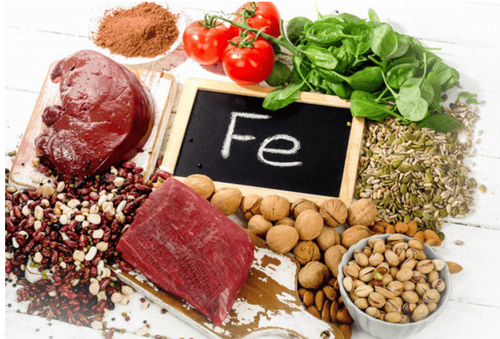
Sắt có vai trò quan trọng trong sự phát triển của trẻ
3. How much iron do children need?
Iron is essential for a rapidly growing child. That's why so many cereals and other toddler foods are fortified with iron.Recommended daily iron requirements vary with age.
0 - 6 months old: 0.27 milligrams (mg) daily 6-12 months old: 11 mg daily From 1 to 3 years old: 7 mg daily From 4 to 8 years old: 10 mg daily Preterm babies or low birth weight often need more iron than babies born with normal weight
4. Heme iron supplementation versus non-heme iron
Iron in the diet comes in two main forms: heme and nonheme. Plants contain nonheme iron. Meats and seafood contain both heme and nonheme iron.The body does not absorb iron in the nonheme form as easily as heme iron. This is even more important for both children and adults. If your child is a vegetarian or most of his daily diet is vegetarian, aim to get twice the recommended amount of iron.
The body absorbs iron better when you consume it with vitamin C. To help your body absorb more iron, eat iron-rich foods along with foods rich in vitamin C.
Some foods rich in vitamin C include oranges, grapefruits, kiwi fruit, broccoli, and tomatoes. sour, strawberry, bell pepper, papaya, cantaloupe, sweet potato.
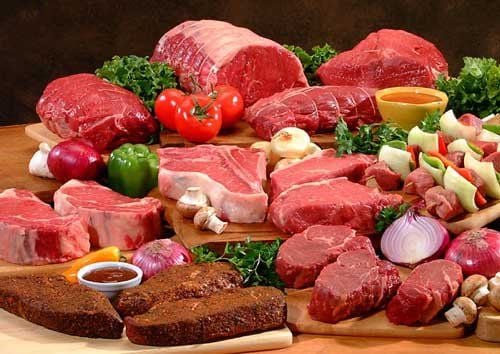
Các thực phẩm chứa nhiều sắt
5. Iron-rich foods that young children should be supplemented with.
Feeding your child iron-rich foods along with foods high in vitamin C can help reduce your child's risk of iron deficiency.5.1. Lean
Cattle and poultry meat contains a large amount of heme iron, which is easily digested by the body. Beef, offal and liver in particular have a lot of iron. For example, an 85g serving of beef liver contains 5 mg of iron.Dark chicken and turkey are also good sources of iron.
You can make cooked, tender chicken or beef stews for young children. Make sure to remove the fatty part of the meat as there is very little iron in the fatty parts. Spaghetti with meat and tomato sauce is a very suitable choice and contains a lot of iron.
5.2. Fortified Cereals
Iron-fortified cereals and oatmeal are a good way to make sure your toddler is getting enough iron.One serving of iron-fortified cereal typically has 100% of the daily iron requirement in just one serving. Exact quantities will vary, so be sure to check the label. Dry cereals, like Cheerios, are also often fortified with iron.
One cup of uncooked, rolled oats contains about 3.5 mg of iron. You can give your toddler breakfast cereal or oatmeal with some blueberries or strawberries for extra vitamin C.
Note that although iron-fortified cereals and juices can provide extra iron, but they are also often high in sugar.
5.3. Bean
If you're aiming for a vegetarian diet or your kids don't like meat, beans are another great choice. Soybeans, lima beans, kidney beans, lentils, and other legumes are good choices. Beans contain iron, fiber, and other essential vitamins and minerals.Example:
Half a cup of white beans has 4 mg of iron Half a cup of lentils has 3 mg of iron Half a cup of red beans has 2 mg of iron Crush some cooked lentils or make soup. Try mashing some iron-fortified rice with beans for a full protein and high-iron meal.
You can also try feeding your child some low-sugar baked beans with a piece of whole-wheat bread for an iron-rich lunch. Or maybe mashed sweet potatoes add vitamin C to the dish.
Chickpeas, known by some as garbanzo beans, are another high-iron bean and a great snack for kids (and adults!). You can mix chickpeas to make your own iron-rich hummus.
Be aware that some people are allergic to chickpeas. If you are unsure about giving your child chickpeas, ask your doctor first.
5.4. Spinach
Dark, leafy greens like kale, broccoli, and spinach are among the best vegetables for iron.Half a cup of boiled, drained spinach contains about 3 mg of iron. Try giving your child chopped spinach, steam it, or add chopped spinach or other greens to cheese, eggs, or make smoothies.
5.5. Raisins and other dried fruits
Children love to snack on raisins. In the dried fruits can help children increase iron, and help prevent constipation. A quarter cup of raisins has about 1 mg of iron.5.6. Pumpkin seeds
Pumpkin seeds are a good source of protein, fiber, healthy fats and minerals, including iron. A quarter cup of pumpkin seeds contains 2.5 mg of iron.Try making a sugar mixture with raisins, prunes, dried apricots, pumpkin seeds and sunflower seeds.
Remember that raisins and seeds can pose a choking hazard to young children. Mash or cut these foods into small pieces and watch them while they chew.
5.7. Egg
Eggs are a good source of protein, essential vitamins and minerals, including iron. One hard-boiled egg contains 1 mg of iron.For many years, people tried to limit their eggs because eggs also contain cholesterol, which increases the risk of cardiovascular disease (CVD). However, current research suggests that eggs do not increase the risk of CVD.
Young children can eat eggs in many ways, such as:
Medium boiled and served with toast Hard boiled, whole or crushed Fried eggs. You can add chopped spinach and other iron-rich foods to your egg dishes. Try different ways to see which way your child likes them best.
Always make sure eggs are fresh and thoroughly cooked. If possible, use fresh, locally sourced organic eggs.
5.8. Peas
Peas contain protein, fiber, iron and other nutrients. Many young children like them very much, they are easy to prepare and pair well with many dishes.Half a cup of chickpeas provides 1 mg of iron. You can boil peas and serve as a side dish, mash them with baby vegetables or add them to soups, stews and savory rice.
Keep a bag of peas in the freezer or get fresh peas in a seasonal pod. Ask your child to help you peel fresh peas.
Peas can be a choking hazard for young children, so consider mashing them up for babies.
5.9. Tuna
Canned tuna is a low-calorie and low-fat addition to your child's diet, it also provides iron and other important nutrients like protein and omega-3 fatty acids.90g of tuna canned in water contains 1 mg of iron. Combine chopped tuna with pureed vegetables to increase your child's iron intake, but avoid having a seafood allergy run in your family.
5.10. Tofu
Tofu is a light and versatile plant-based food that is full of protein, calcium, iron and other nutrients. It can provide some of the essential nutrients your kids need if they don't eat meat.Half a cup of tofu contains 3 mg of iron. Tofu comes in many different forms. Tofu pieces, you can chop and add to salads or stir-fry, bake or use to make nuggets. Young tofu has a softer texture. You can mix it with salad dressings, add it to smoothies, or add fruit to desserts.
There have been concerns about whether isoflavones, an ingredient in tofu, could harm hormone balance. Research has shown that this has no scientific basis.
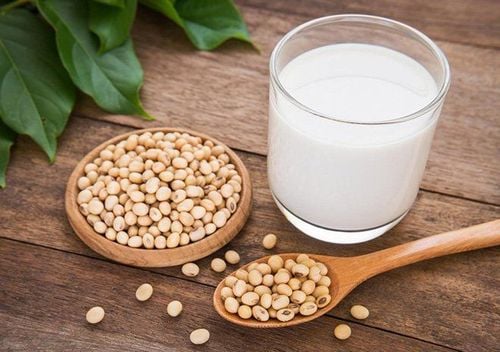
Đậu phụ là một trong những thực phẩm bổ sung sắt cho trẻ
6. Should young children take iron supplements from pharmaceuticals?
According to the National Institutes of Health, about 12% of babies in the first year and about 8% of toddlers have low iron.It is best for your child to get nutrients from food, but if the doctor thinks your child may have iron deficiency anemia, he or she may prescribe iron supplements.
Follow your doctor's instructions and keep all supplements out of the reach of children. Consuming too much iron can lead to serious health problems.
Never give your child iron supplements without consulting a doctor first.
When a child shows abnormal signs of health, parents can take the child to Vinmec Health system for timely examination and treatment.
In addition to dietary supplements, parents can give their children support foods containing iron and essential micro-minerals such as zinc, lysine, chromium, selenium, ... to help fully meet their needs. nutritional requirements in children. At the same time, these essential vitamins also support digestion, enhance nutrient absorption, help improve anorexia, and help children eat well.
Please regularly visit Vinmec.com website and update useful information to take care of your baby and family.
Reference source: healthline.com







